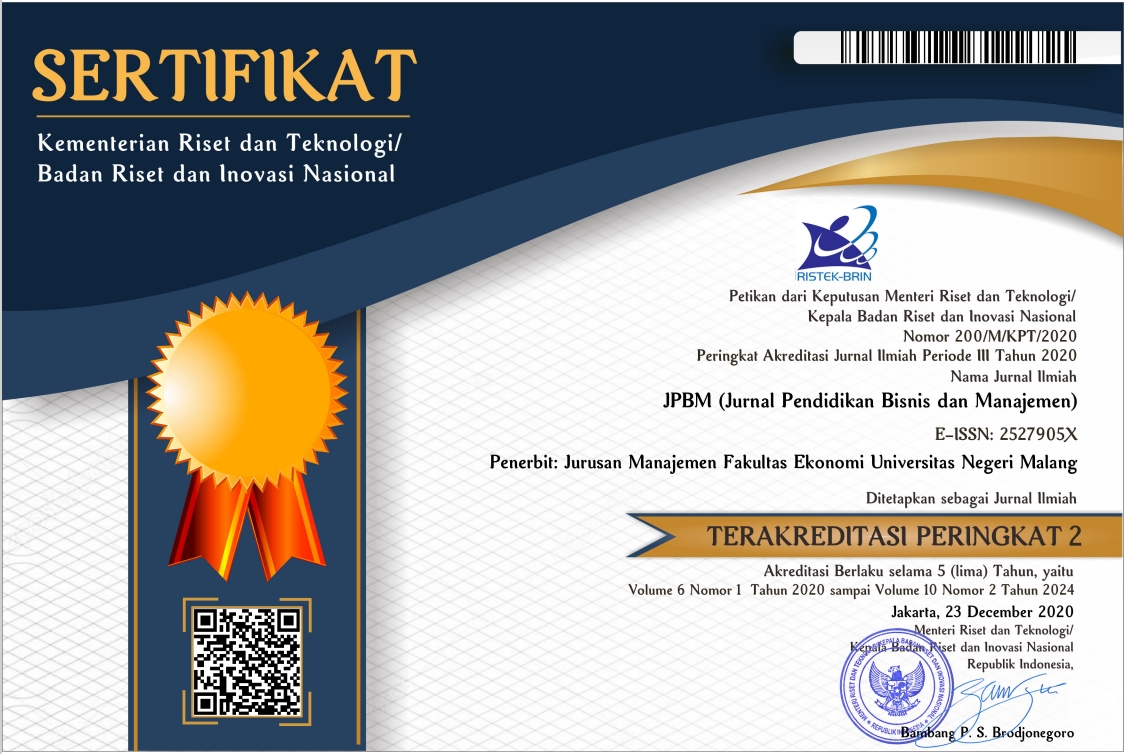Generation Z’s Intention to Apply: An Approach to Job Preferences, Organization Attractiveness, Person-Organization Fit, and Social Media Usage
Abstract
Talent wars reveal that a company’s different human capital can provide competitiveness and agility. Organizations should offer an attractive workplace location, considering the target’s expectations. Generation Z accounts for 19.42 percent of the global population and will make up most of the incoming workforce. Using the structural equation modeling (SEM), the study examines data on the intention to apply among 350 nearly-graduated college students. Findings support a significant positive impact of Generation Z job preferences and organizational attractiveness on their intention to apply for jobs. When choosing a career, the top three priorities for respondents are health insurance, a coaching manager, and job security. Recruitment messages in job ads should most likely appear on the company’s social media account, focusing on more psychological and organizational attributes that fit the preferences of generation Z, particularly job benefits. Instead of a mediating effect, person-organization fit and social media direct correlation robustly predict the intention to apply for a job.
Keywords: Generation Z, Attractiveness, P-O fit, Social media, Intention to apply
Full Text:
PDFReferences
Acheampong, N. A. A. (2021). Reward preferences of the youngest generation: attracting, recruiting, and retaining Generation Z into public sector organizations. Compensation & Benefits Review, 53(2), 75–97. https://doi.org/10.1177/0886368720954803
Ajmain, T. (2020). Impacts and effective Communication on Generation Z in industrial revolution 4.0 Era. JETAL: Journal of English Teaching & Applied Linguistic, 2(1), 37–42. https://doi.org/10.36655/jetal.v2i1.204
Baron, R. M., & Kenny, D. A. (1986). The moderator–mediator variable distinction in social psychological research: Conceptual, strategic, and statistical considerations. Journal of Personality and Social Psychology, 51(6), 1173–1182. https://doi.org/10.1037/0022-3514.51.6.1173
Bondarouk, T., & Olivas-Luján, M. R. (2013). Social Media in human resources management. in advanced series in management (p. iii). Emerald Group Publishing Limited. https://doi.org/10.1108/S1877-6361(2013)0000012019
Boomsma, A., & Hoogland, J. (2001). The robustness of LISREL modeling revisited,” in Cudeck, R., du Toit, S. and Sorbom, D. (Eds), Structural Equation Modeling: Present and Future, Scientific Software International.
Boon, C., & Biron, M. (2016). Temporal issues in person–organization fit, person–job fit and turnover: The role of leader–member exchange. Human Relations, 69(12), 2177–2200. https://doi.org/10.1177/0018726716636945
BPS, B. (2019). Proporsi Individu Yang Menggunakan Internet Menurut Kelompok Umur (Persen). Badan Pusat Statistik. https://www.bps.go.id/indicator/27/1228/1/proporsi-individu-yang-menggunakan-internet-menurut-kelompok-umur.html
BPS, B. (2021). Statistics Indonesia Releases 2020 Census Results. Deputy Cabinet Secretary for State Document and Translation. https://setkab.go.id/en/statistics-indonesia-releases-2020-census-results/
Byrne, B. M. (2014). Structural equation modeling with LISREL. basic concepts, applications, and programming Byrne,. Psychology Press.
Cable, D. M., & Judge, T. A. (1994). Pay preferences and job search decisions: A person-organization fit perspective. Personnel Psychology, 47(2), 317–348. https://doi.org/10.1111/j.1744-6570.1994.tb01727.x
Cable, D. M., & Judge, T. A. (1996). Person–organization fit, job choice decisions, and organizational entry. Organizational Behavior and Human Decision Processes, 67(3), 294–311. https://doi.org/10.1006/obhd.1996.0081
Cable, D. M., & Parsons, C. K. (2001). Socialization tactics and person-organization fit. Personnel Psychology, 54(1), 1–23. https://doi.org/10.1111/j.1744-6570.2001.tb00083.x
Carless, S. A. (2005). Person-job fit versus person-organization fit as predictors of organizational attraction and job acceptance intentions: A longitudinal study. Journal of Occupational and Organizational Psychology, 78(3), 411–429. https://doi.org/10.1348/096317905X25995
Chillakuri, B. (2020). Understanding Generation Z expectations for effective onboarding. Journal of Organizational Change Management, 33(7), 1277–1296. https://doi.org/10.1108/JOCM-02-2020-0058
Chu, S.-C., Kamal, S., & Kim, Y. (2013). Understanding consumers’ responses toward social media advertising and purchase intention toward luxury products. Journal of Global Fashion Marketing, 4(3), 158–174. https://doi.org/10.1080/20932685.2013.790709
Collins, C. J. (2007). The interactive effects of recruitment practices and product awareness on job seekers’ employer knowledge and application behaviors. Journal of Applied Psychology, 92(1), 180–190. https://doi.org/10.1037/0021-9010.92.1.180
Collins, C. J., & Stevens, C. K. (2002). The relationship between early recruitment-related activities and the application decisions of new labor-market entrants: A brand equity approach to recruitment. Journal of Applied Psychology, 87(6), 1121–1133. https://doi.org/10.1037/0021-9010.87.6.1121
Diamantopoulos, A., & Siguaw, J. (2000). Introducing LISREL. SAGE Publications, Ltd. https://doi.org/10.4135/9781849209359
Dijkmans, C., Kerkhof, P., & Beukeboom, C. J. (2015). A stage to engage: Social media use and corporate reputation. Tourism Management, 47, 58–67. https://doi.org/10.1016/j.tourman.2014.09.005
Dutta, D., Mishra, S. K., & Varma, A. (2021). Predictors of job pursuit intention across career stages: A multi-phase investigation. The International Journal of Human Resource Management, 32(20), 4215–4252. https://doi.org/10.1080/09585192.2019.1651376
Fourqoniah, F. (2015). Pengaruh adopsi jejaring sosial terhadap intensi berwirausaha mahasiswa program sarjana di Indonesia. Jurnal Pendidikan Bisnis dan Manajemen, 1(3), 11.
Gabrielova, K., & Buchko, A. A. (2021). Here comes Generation Z: Millennials as managers. Business Horizons, 64(4), 489–499. https://doi.org/10.1016/j.bushor.2021.02.013
Gomes, D., & Neves, J. (2011). Organizational attractiveness and prospective applicants’ intentions to apply. Personnel Review, 40(6), 684–699. https://doi.org/10.1108/00483481111169634
Graczyk-Kucharska, M., & Erickson, G. S. (2020). A person-organization fit Model of Generation Z: Preliminary studies. Journal of Entrepreneurship, Management and Innovation, 16(4), 149–176. https://doi.org/10.7341/20201645
Grow, J. M., & Yang, S. (2018). Generation-Z Enters the advertising workplace: expectations through a gendered lens. Journal of Advertising Education, 22(1), 7–22. https://doi.org/10.1177/1098048218768595
Gupta, S., & Saini, G. K. (2020). Information Source credibility and job seekers’ intention to apply: The Mediating role of brands. Global Business Review, 21(3), 743–762. https://doi.org/10.1177/0972150918778910
Hair, J. (2011). PLS-SEM: Indeed a silver bullet. Journal of Marketing Theory and Practice, 19(2), 139–151.
Half, R. (2015, August 1). Get ready for Generation Z. The Robert Half Blog, 127(28), 42–45.
Hanu, C., Amegbe, H., & Mensah, P. (2021). Your Future Employer: Employer Branding, Reputation, and Social Media. African Journal of Inter/Multidisciplinary Studies, 3(1), 1–18. https://doi.org/10.51415/ajims.v3i1.860
Haryono, S., Puryanto, D., & Mitardja, H. (2016). Metode SEM untuk penelitian manajemen dengan AMOS LISREL PLS (1st ed.). PT. Intermedia Personalia Utama.
Hayes, A. F. (2009). Beyond Baron and Kenny: Statistical mediation analysis in the new millennium. Communication Monographs, 76(4), 408–420. https://doi.org/10.1080/03637750903310360
Highhouse, S., Lievens, F., & Sinar, E. F. (2003). Measuring attraction to organizations. Educational and Psychological Measurement, 63(6), 986–1001. https://doi.org/10.1177/0013164403258403
Hoogland, J., & Boomsma, A. (1998). Robustness studies in covariance structure modeling—An overview and a meta-analysis. Sociological Methods & Research, 26. https://doi.org/10.1177%2F0049124198026003003
Hu, L., & Bentler, P. M. (1999). Cutoff criteria for fit indexes in covariance structure analysis: Conventional criteria versus new alternatives. Structural Equation Modeling: A Multidisciplinary Journal, 6(1), 1–55. https://doi.org/10.1080/10705519909540118
Igbaria, M., Zinatelli, N., Cragg, P., & Cavaye, A. L. M. (1997). Personal Computing Acceptance Factors in Small Firms: A Structural Equation Model. MIS Quarterly, 21(3), 279. https://doi.org/10.2307/249498
Iorgulescu, M. C. (2016). CMJ2016_I1_6.pdf. Cross-Cultural Management Journal, 18(1), 47–54.
Janssen, D., & Carradini, S. (2021). Generation Z workplace communication habits and expectations. IEEE Transactions on Professional Communication, 64(2), 137–153. https://doi.org/10.1109/TPC.2021.3069288
Kemp, S. (2022). Digital 2022: Indonesia. https://datareportal.com/reports/digital-2022-indonesia
Kessler, E. H. (2013). Encyclopedia of management theory. SAGE Publications, Ltd. https://doi.org/10.4135/9781452276090
Kline, R. (2016). Principles and practice of structural equation modeling (4th ed.). Guilford Pers.
Lauver, K. J., & Kristof-Brown, A. (2001). Distinguishing between Employees’ Perceptions of Person–Job and Person–Organization Fit. Journal of Vocational Behavior, 59(3), 454–470. https://doi.org/10.1006/jvbe.2001.1807
Lazányi, K., & Bilan, Y. (2017). Generetion Z on the labour market – Do they trust others within their workplace? Polish Journal of Management Studies, 16(1), 78–93. https://doi.org/10.17512/pjms.2017.16.1.07
Marron, M. B. (2015). New generations require changes beyond the digital. Journalism & Mass Communication Educator, 70(2), 123–124. https://doi.org/10.1177/1077695815588912
Martínez‐López, F. J., Gázquez‐Abad, J. C., & Sousa, C. M. P. (2013). Structural equation modelling in marketing and business research: Critical issues and practical recommendations. European Journal of Marketing, 47(1/2), 115–152. https://doi.org/10.1108/03090561311285484
Mintel, M. (2019). Marketing to Generation Z. https ://reports.mintel.com
Pandita, D. (2021). Innovation in talent management practices: Creating an innovative employer branding strategy to attract generation Z. International Journal of Innovation Science, ahead-of-print(ahead-of-print). https://doi.org/10.1108/IJIS-10-2020-0217
Patel, D. (2017, Agustus). The top 5 traits Gen Z looks for in leaders. Forbes. https://www.forbes.com/sites/deeppatel/2017/08/27/the-top-5-traits-gen-z-looks-for-in-leaders/?sh=7c9dc4b9609d
Patiro, S. P. S., Budiyanti, H., & Hendarto, K. A. (2022). Panic-buying behavior during the Covid-19 pandemic in Indonesia: A social cognitive theoretical model. Gadjah Mada International Journal of Business, 24(1), 31.
pddikti, K. (2020). Statistik mahasiswa- mahasiswa berdasarkan jenis kelamin [Statistik]. Kementrian Pendidikan dan Kebudayaan Indonesia. https://pddikti.kemdikbud.go.id/mahasiswa
Priyadarshini, C., Kumar, Y., & Jha, R. (2017). Employer Attractiveness through social media: A phenomenological study. The Qualitative Report. https://doi.org/10.46743/2160-3715/2017.2663
Quadlin, N. (2018). The Mark of a Woman’s Record: Gender and Academic Performance in Hiring. American Sociological Review, 83(2), 331–360. https://doi.org/10.1177/0003122418762291
Roberson, Q. M., Collins, C. J., & Oreg, S. (2005). The effects of recruitment message specificity on applicant attraction to organizations. Journal of Business and Psychology, 19(3), 319–339. https://doi.org/10.1007/s10869-004-2231-1
Roblek, V., Mesko, M., Dimovski, V., & Peterlin, J. (2019). Smart technologies as social innovation and complex social issues of the Z generation. Kybernetes, 48(1), 91–107. https://doi.org/10.1108/K-09-2017-0356
Santiago, J. (2019). The relationship between brand attractiveness and the intent to apply for a job: A millennials’ perspective. European Journal of Management and Business Economics, 28(2), 142–157. https://doi.org/10.1108/EJMBE-12-2018-0136
Schneider, B. (1987). The people make the place. Personnel Psychology, 40(3), 437–453. https://doi.org/10.1111/j.1744-6570.1987.tb00609.x
Schroer, W. J. (2008). Generations X, Y, Z and the others. WJSchroer. http://socialmarketing.org/archives/generations-xy-z-and-the-others/
Shaari, H. (2022). Millennials’ response toward luxury fashion brands: The balance theory’s perspective. Gadjah Mada International Journal of Business, 24(1), 26.
Sivertzen, A.-M., Nilsen, E. R., & Olafsen, A. H. (2013). Employer branding: Employer attractiveness and the use of social media. Journal of Product & Brand Management, 22(7), 473–483. https://doi.org/10.1108/JPBM-09-2013-0393
Szymkowiak, A., Melović, B., Dabić, M., Jeganathan, K., & Kundi, G. S. (2021). Information technology and Gen Z: The role of teachers, the internet, and technology in the education of young people. Technology in Society, 65, 101565. https://doi.org/10.1016/j.techsoc.2021.101565
Taylor, M. S., & Bergmann, T. J. (1987). Organizational recruitment activities and applicants’ reactions at different stages of the recruitment process. Personnel Psychology, 40(2), 261–285. https://doi.org/10.1111/j.1744-6570.1987.tb00604.x
Thangavel, P., Pathak, P., & Chandra, B. (2019). Consumer decision-making style of Gen Z: A Generational cohort analysis. Global Business Review, 097215091988012. https://doi.org/10.1177/0972150919880128
Twenge, J. M. (2017). iGEN: Why today’s super-connected kids are growing up less rebellious, more tolerant, less happy-- and completely unprepared for adulthood and (what this means for the rest of us). Atria Books.
Wei, Y.-C., Chang, C.-C., Lin, L.-Y., & Liang, S.-C. (2016). A fit perspective approach in linking corporate image and intention-to-apply. Journal of Business Research, 69(6), 2220–2225. https://doi.org/10.1016/j.jbusres.2015.12.033
Wibowo, L. A., Lisnawati, L., & Adzimaturrahmah, R. (2019). Social media customer expectations: brand engagement in maintaining customer loyalty. Jurnal Pendidikan Bisnis dan Manajemen, 5(3), 137–146. https://doi.org/10.17977/um003v5i32019p137
Zhao, X., Lynch, J. G., & Chen, Q. (2010). Reconsidering Baron and Kenny: Myths and Truths about Mediation Analysis. Journal of Consumer Research, 37(2), 197–206. https://doi.org/10.1086/651257
DOI: http://dx.doi.org/10.17977/um003v8i32022p168
Refbacks
- There are currently no refbacks.
JPBM (Jurnal Pendidikan dan Bisnis Manajemen) is licensed under a Creative Commons Attribution-NonCommercial-ShareAlike 4.0 International License.
JPBM (Jurnal Pendidikan dan Bisnis Manajemen) is abstracted and indexed in :

















